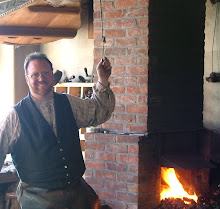In the traditional Blacksmith shop at The Farmers’ Museum we make and repair tools as needed. Several times a year we need to make a new ash hammer handle. We have discussed in the past how a
Froe is used to split out the billets of wood to make the handles. Then we use the drawknife and
Shaving Horse to shape the handle. But where to we get the billets of wood to start with? They don’t look like modern lumber.
We are fortunate to have many acres of forest as part of our farm. This fall both Hurricane Irene and Tropical Storm Lee brought high winds to our area this fall (2011). Several mature Ash trees were uprooted in the woods. As the damage is cleared we put aside some logs to make tool handles and other things. One foot, two foot, and three foot sections went in the shed to make hammer and sledgehammer handles.
Using an axe, a sledge and wedges, and a mallet and froe we split up the wood into billets to dry for future tool handles. First the logs were split into halves, then quarters, then eighths. Sap and heart wood is split off if it looks weak. Knotty pieces not good for handles go into the kindling pile.
The Froe is used to split off the bark and wet cambium layer. The resulting billets are sqaure or keystone shaped in cross section. This will let the handle billets dry evenly and be less likely to check.
Some may be used for hammers. Other to make chisel, screwdriver, or file handles. It is good to have a stockpile against future need.












